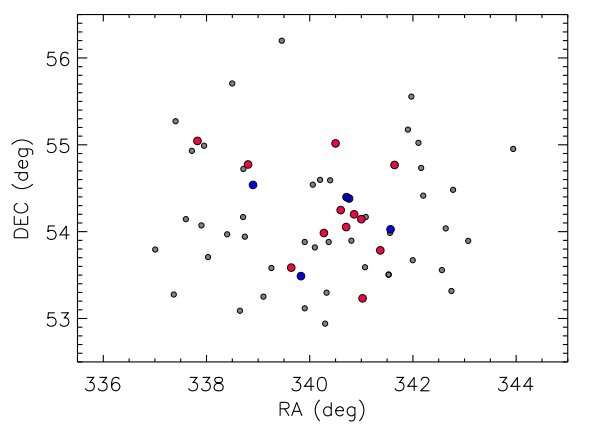October 14, 2019 report
Open cluster ASCC 123 investigated in detail

Using the Galileo National Telescope, astronomers have conducted a high-resolution spectroscopic study of the open cluster ASCC 123 as part of the Stellar Population Astrophysics (SPA) project. Results of the new research, presented in a paper published October 4 on arXiv.org, provide important information about fundamental parameters of 17 candidate members of ASCC 123, shedding more light on the properties of this little-studied cluster.
Formed from the same giant molecular cloud, open clusters are groups of stars loosely gravitationally bound to each other. So far, more than 1,000 of them have been discovered in the Milky Way galaxy, and scientists are still looking for more, hoping to find a variety of these stellar groupings. Expanding the list of known galactic open clusters could be crucial for improving the understanding of the formation and evolution of the Milky Way.
Discovered in 2005, ASCC 123 is an open cluster located some 760 light years away in the second galactic quadrant. To date, only few studies of this cluster have been conducted to determine its basic properties. Results of the observations of ASCC 123 performed so far suggest that the cluster is about 130 million years old and contains from 24 to 121 stars as most likely members.
Now, a group of astronomers led by Antonio Frasca of Catania Observatory in Italy has investigated ASCC 123 in detail by performing the first high-resolution spectroscopic study of this cluster. For this purpose, they employed the 3.6-meter Galileo National Telescope located at El Roque de los Muchachos Observatory in La Palma (Spain). The observations were conducted in August 2018 and August 2019 under the SPA program.
"In the framework of the SPA project, we have studied a sample of 17 candidate members to the young open cluster ASCC 123. We have performed, for the first time, a thorough analysis of their properties based on high-resolution spectroscopy with the aim of improving our knowledge of this nearby and very sparse cluster," the astronomers wrote in the paper.
Out of the 17 studied candidate members of ASCC 123, five turned out to be double-lined spectroscopic binaries, while three of them were ruled out as members of the cluster. The three stars were classified as non-members on the basis of their astrometry and lithium content.
According to the research, data from the study of the single stars that remained candidate members of ASCC 123 indicate that the average extinction toward the cluster is around 0.13 mag. This value was calculated from the atmospheric parameters, particularly effective temperature (between 5,200 and 10,500 K for the investigated sample), along with the photometric data.
The median radial velocity for the cluster was found to be approximately -5.6 km/s, while the weighted average was calculated to be at a level of -4.5 km/s.
Furthermore, when it comes to chemical composition of ASCC 123, the study found that it has an average metallicity of about 0.14, which is expected for clusters at similar distance from the Milky Way's center. All in all, the chemical composition of ASCC 123 was found to be compatible with the solar neighborhood. However, some elements, like zinc and yttrium, display abundance ratios slightly different when compared to average trends.
From the lithium abundance and hydrogen-alpha emission the researchers inferred an age of ASCC 123. They calculated that the cluster is between 100 and 250 million years old.
More information: A. Frasca, et al. Stellar population astrophysics (SPA) with the TNG. Characterization of the young open cluster ASCC 123. arXiv:1910.02006v1 [astro-ph.SR]: arxiv.org/abs/1910.02006
© 2019 Science X Network



















